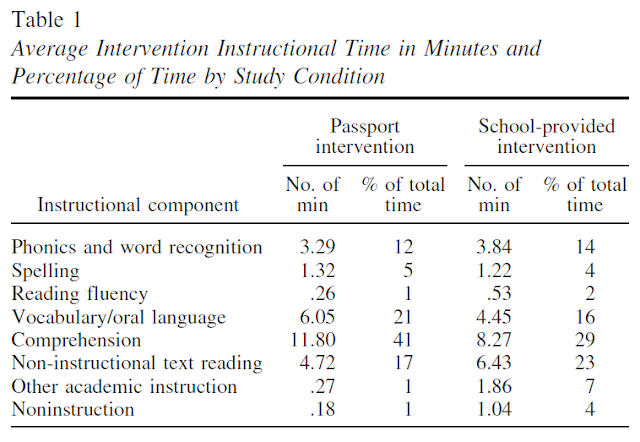Explicitly Teaching Reading Comprehension
Reading is taught in the early elementary years. Reading difficulties during the early years can arise from lack of fluency, limited vocabulary, or poor word recognition. Interventions are often designed to address these various components of reading. Going further, however, students also need to understand what they are reading. Students should be able to derive meaning from text. This is how reading becomes a vehicle for further learning. One might therefore ask whether students with reading difficulties can benefit from interventions that focus on reading comprehension. The answer, according to research, is "yes".
Wanzek and coworkers describe the comprehension section in the following:
A paper scheduled to be published in the Journal of Educational Psychology specifically looks at an intervention called Passport to Literacy and finds significant improvements in reading comprehension for fourth grade students that have reading difficulties. The intervention is done daily for 30 minutes over 25 weeks. How this intervention differs from others lies on its emphasis on teaching students strategies for reading comprehension:
Wanzek and coworkers describe the comprehension section in the following:
...during the second component, Read to Understand, students were taught the meaning of vocabulary words introduced during Word Works, as well as comprehension skills and strategies to apply while reading fiction and nonfiction. For example, lessons offered explicit instruction in previewing, setting purpose, text structure and evaluation, making inferences and taking perspectives, drawing conclusions, author’s purpose, sequencing, main idea, summarizing, independent reading fix-up strategies, teacher and reader questioning, and making connections within and across texts.This intervention involves explicit instruction. In addition, each class in this intervention is a small group, four to seven students. And from a relatively large sample (almost 500 students), the conclusions are as follows:
Findings indicated the treatment significantly outperformed the comparison on reading comprehension (Effect Size = 0.38), but no overall group differences were noted on word reading or vocabulary. Students’ initial word reading scores moderated this effect. Reading comprehension effects were similar for English learner and non-English learner students.There is a lot of doubt regarding reading comprehension interventions. Daniel Willingham is convnced that reading comprehension strategy instruction does not really enhance comprehension skills. Willingham agrees that teaching strategies is useful, but should be brief and explicit. He however offers another possible reason why reading comprehension instruction is working:
...Reading is not just about decoding; you are meant to understand something. The purpose is communication. This message may be particularly powerful for struggling readers, whose criterion for “understanding” is often too low (Markman, 1979). One of us works extensively with struggling adolescent readers who frequently approach the task of reading as getting to the last word on the page....The study by Wanzek and coworkers focuses on struggling readers and indeed the authors include the following in what they think are some of the limitations of their study.
We also recruited schools that were diverse and served students from low socioeconomic backgrounds, so our findings might not generalize to schools serving students from higher socioeconomic backgrounds. The majority of our ELs in our study were Hispanic and our findings may not generalize to students from other language backgrounds, particularly those with orthographies that are very different than English. Further, effect sizes are interpretable relative to the comparison condition in the participating schools where very few struggling readers received supplemental interventions as a part of their typical practice.Finally, whether these findings are transferable or not is obviously dependent on how well the intervention is implemented since explicit instruction is an essential part. In the study, trained research personnel (not classroom teachers) have provided the intervention.

Comments
Post a Comment